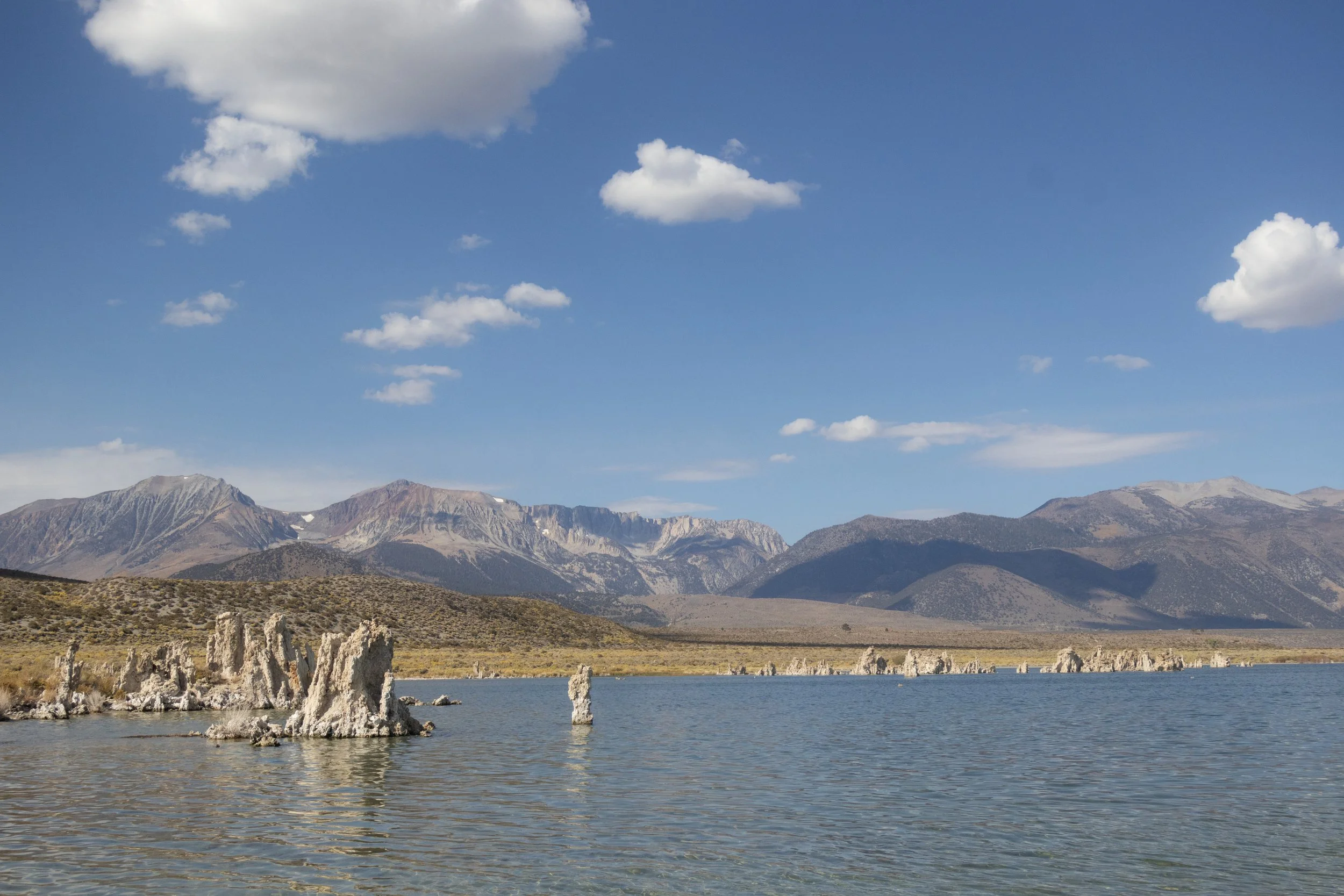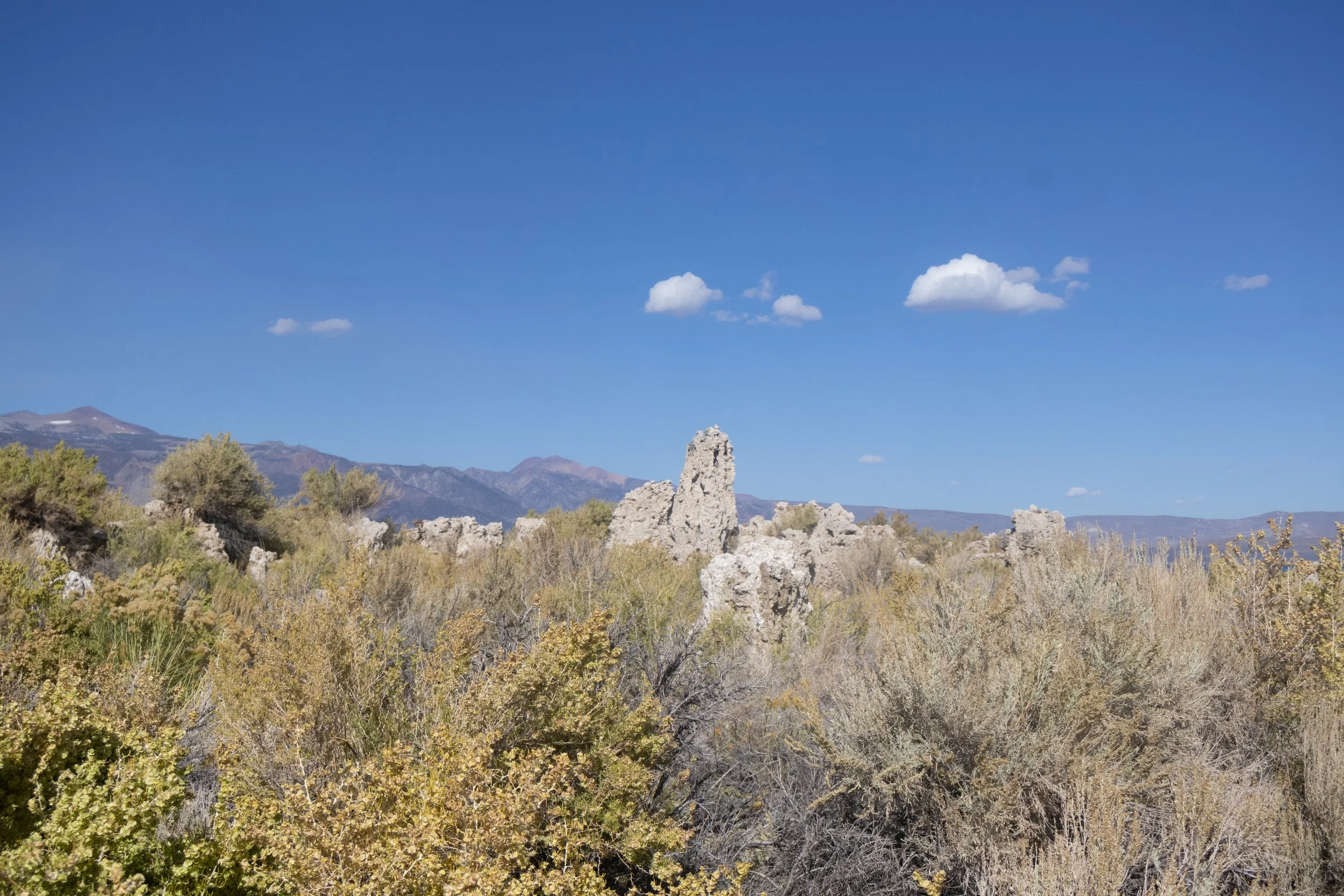“Environmental movements normally are for the native species. They are for the endemic species. This thing's non-native, it causes damage to the native species, and it challenges the way we understand environmental management. But the life lesson there is sometimes done is better than perfect.” With this, Ryan closed his time with Semester in the West leaving us perplexed wondering how German Brown Trout saved Mono Lake.
Two days prior, Ryan Garret, education director for the Mono Lake Committee, stood at the South Tufa trailhead on the shore of Mono Lake. The committee’s primary mission: to right the wrongs inflicted on the Lake by the diversion of its water to Los Angeles via the LA Aqueduct: “They diverted four of the five tributary streams that feed Mono Lake. when you cut off the main water supply, Mono Lake is going to shrink”. As the trail led down a soft slope, a pastel panorama of colors danced in the wind, tickling the rubber rabbitbrush, sagebrush, and caterpillar greasewood. “Rubber rabbitbrush, while native, is considered a pioneering species, and specifically a pioneering species of disturbed ecosystems.” Reaching beyond the tips of the brush are gnarled spires of limestone called Tufa. These emaciated carbonate fingers reach longingly up at the sky. These features draw tourists to the lake en masse. Ryan stands at the foot of a Tufa; “What's super interesting about these towers, is that they can only grow underwater… if we were standing here in 1941 we would all be well underwater.” These Tufa are captivating, the plants, beautiful- yet they are the product of the starvation of the lake whose water was sent to a cause deemed more worthy.
The shore is a light gray sparkling as obsidian flakes glint in the sunlight. Between glistening sand and lapping water is a foot-wide buffer of dense black. A boy dressed in a tracksuit runs through it and as he does, the solid black band dissolves into the air, as a sea of hundreds of thousands of alkali flies part to clear his path. The whole lake pulses with life. Below the surface species found nowhere else in the world thrive. Brine shrimp that have evolved with the lake for thousands of years would disappear if it were to shrink any more. The same goes for the endemic alkali fly, a species that fascinates many with its ability to live most of its life underwater. All of this beauty and fantastical geology reflects a noxious reality–Mono Lake is showing us these things because she is dying.
In the early 1900’s the Los Angeles Department of Water and Power’s began developing the LA Aqueduct. The project was designed to meet the needs of the growing city of Los Angeles by drawing water from less populated areas in California. In 1941 Grant Lake, seven miles above Mono Lake, was re-engineered to serve as Grant Reservoir holding the increased water supply produced by the Aqueduct expansion into the Mono basin. It cut off every drop of the lake's supply. The ensuing 40 years of diversion, caused Mono Lake’s water level to recede by 45 feet, almost half of its total volume. It was projected in 1979 that without the return of water to Mono Lake, the entire ecosystem would collapse by the mid-1990s to early 2000s. As the lake levels dropped the tufa were exposed; a check engine light. Garret kneels on the earthen dam that created Grant Reservoir. The Reservoir and Mono Lake are connected by the tributary stream Rush Creek. Garret explains the four ways that water leaves Grant Reservoir: evaporation, a return ditch, the Los Angeles Aqueduct, and, the spillway, the last is important, and it comes with a story. In the early 1900’s Brown trout were introduced to Mono Lake’s tributaries by hatcheries and 30 years later there was a well-established fishery.
When the El Niños of 1982 and 1983 sent water through Rush Creek 30,000 trout came with it and took up residence below the reservoir. The fishery was thriving again, and anglers rejoiced, praising LA DWP for the spill. The department accepted the praise despite having no intention of sustaining the spillage. November first, the day after the 1984 fishing season ended, LA DWP announced it would be closing the gates, once again drying up the creek and starving Mono of her much-needed water. California Fish and Game planned to salvage as many of the fish as possible for relocation but the Mammoth Flyrodders Association, a powerful special interest group, was able to influence and implement a different solution.
Diving into fish and game code they located codes 5936 and 5937 which stated “The owner of any dam shall allow sufficient water at all times to pass over, around, or through the dam, to keep in good condition any fish that may be planted or exist below the dam.” They successfully argued that these regulations merited an injunction against the department’s water management plans, and the department was ordered to ensure that a minimum yearly spill of 14,000-acre feet be allotted to the Rush Creek system. The precedent provided by this decision was applied to the other three tributaries of Mono Lake as well. Today the department has strict limits on how much water it can divert yearly from the lake. But there is something fishy about this solution. The health of Mono Lake has been a priority for conservationists and activists, known as Monophiles, since at least the 1970s. For decades these groups have organized and fought for Mono–to preserve its endemic species and breathtaking scenery. But time and time again they were stymied by the political goliath that was the DWP. The Fish and Game code win that ensured the minimum annual spill, was a double-edged sword. Garret lamented while standing above a small dam on Lee Vining Creek “The trout here, the fish, are the primary political vessel that move the needle to save Mono Lake.” The trout aren't without their negative impact on the ecosystem, “They actually caused quite a bit of environmental damage here in the Sierra Nevada… the brown trout is eating all the tadpoles and all the eggs that Sierra Nevada yellow-legged frog has produced. Same thing is happening with the Yosemite toads just further up the water system.” Garret explains how complex the dynamic produced by introducing this non-native fish species over a century ago has become. “Environmental movements normally are for the native species. They are for the endemic species. This thing's non-native, it causes damage to the native species, and it challenges the way we understand environmental management. But the life lesson there is sometimes Done is better than perfect. If we waited for this perfect ecological solution where we used the Sierra Nevada yellow-legged frog as our political vessel to restore these streams, it would have never happened. Mono Lake would have collapsed. Fish for some reason, more than any other animal that I can think of, move a political needle.”
Ironically, the element that galvanized the reclamation of water necessary to restore Mono Lake and its interrelated ecosystems was interest in a species that’s not native to the system–brown trout. It’s frustrating and instructive that people organized around and were able to drive change because of their investment in restoring recreational fishing, not saving the exceptional Mono Lake ecosystem from brine shrimp and Alkali Flies to migratory birds.
As it stands now, Mono Lake is doing alright. The flies still blanket the shoreline, the shrimp still thrive in its salty body, and birds still take refuge on its glassy surface. However, the battle to save Mono Lake still wages in the courts of law and public opinion. Ryan hopes that through education, activism, and litigation the lake can become its saving grace. Self-supported and self-actualized.




